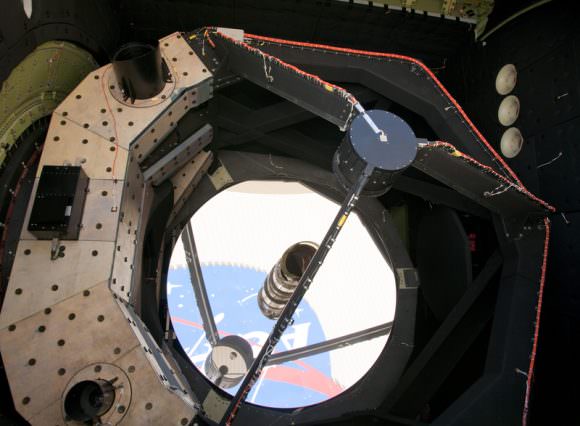Finding atomic oxygen in the Martian atmosphere is very difficult to do, which explains why it’s been 40 years since it was last detected. In the 1970’s, NASA’s Viking and Mariner missions detected Martian atmospheric oxygen, and now, the Stratospheric Observatory for Infrared Astronomy (SOFIA) has detected atomic oxygen in the upper portion of the Martian atmosphere called the mesosphere.
SOFIA is a specially modified Boeing 747 aircraft which carries a 100 inch telescope. It flies at altitudes between 37,000 to 45,000 feet, which puts it above most of the moisture in Earth’s atmosphere. This moisture would otherwise block the infrared radiation that SOFIA “sees.”
“Atomic oxygen in the Martian atmosphere is notoriously difficult to measure,” said Pamela Marcum, SOFIA project scientist. “To observe the far-infrared wavelengths needed to detect atomic oxygen, researchers must be above the majority of Earth’s atmosphere and use highly sensitive instruments, in this case a spectrometer. SOFIA provides both capabilities.”

A special detector on board SOFIA, the German Receiver for Astronomy at Terahertz Frequencies (GREAT) allowed researchers to distinguish Martian atmospheric oxygen from Earthly oxygen. SOFIA-GREAT only detected half the amount of oxygen that scientists expected to find, which is probably due to changes and variations in the atmosphere. These results were published in a 2015 paper in Astronomy and Astrophysics.
Atomic oxygen has a strong effect on Mars’ atmosphere because it affects how other gases escape the atmosphere. It’s extreme volatility means it bonds with nearby molecules very easily; oxygen will combine with almost all chemical elements, except for the noble gases.
SOFIA is the largest airborne observatory in the world, and is a joint project between NASA and the German Aerospace Center. SOFIA has a 20 year mission timeline. Researchers will continue using SOFIA to study the Martian atmosphere, in order to better understand the variations in oxygen content.
SOFIA is not the only mission with eyes on Mars’ atmosphere. NASA’s Mars Atmosphere and Volatile EvolutioN (MAVEN) was launched in 2013 to explore the upper atmosphere of Mars, and how it’s affected by the solar wind. It’s thought that Mars’ atmosphere was much thicker in the past, and has been stripped away over time. Atomic oxygen played a role in Mars’ escaping atmosphere in the past, and no doubt will play a role in the future. SOFIA and other missions like MAVEN will hopefully shed some light on Mars’ past and future atmospheres.

